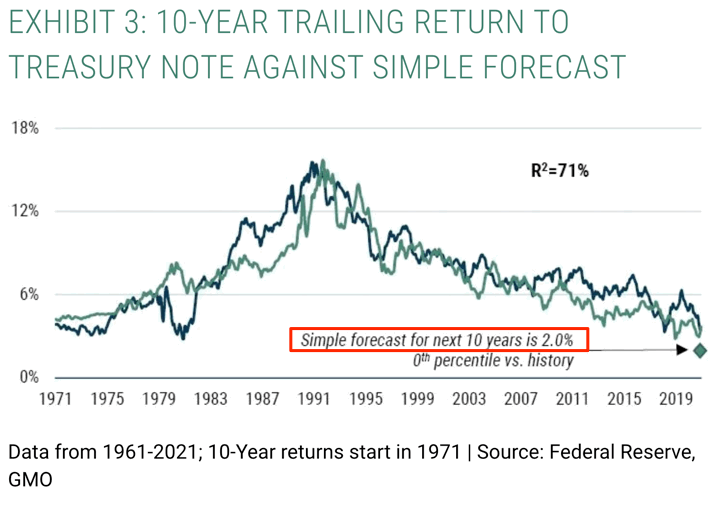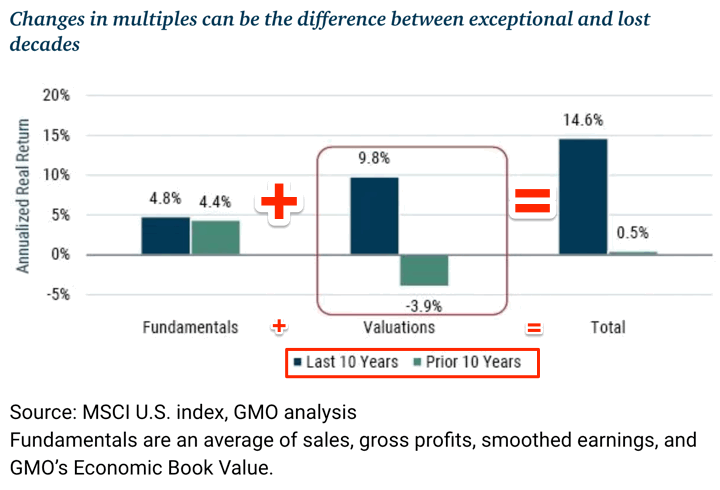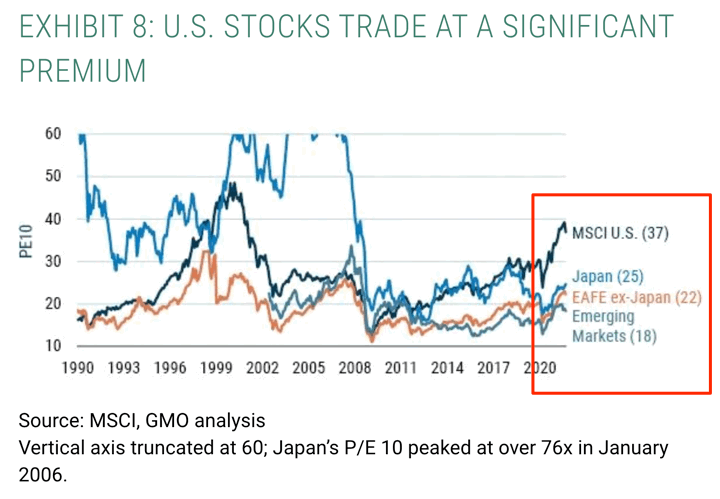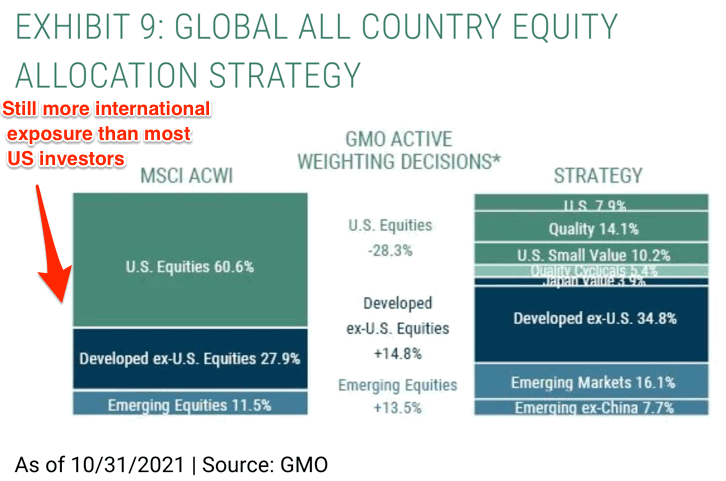 The GMO quarterly letter is on my recurring “must read” list, and the 2021 Q3 letter “Winners, Losers, and the Case for Owning Each” did not disappoint, including some very interesting data for the DIY investor that wants to stay informed. Here are my takeaways and notes:
The GMO quarterly letter is on my recurring “must read” list, and the 2021 Q3 letter “Winners, Losers, and the Case for Owning Each” did not disappoint, including some very interesting data for the DIY investor that wants to stay informed. Here are my takeaways and notes:
For bonds, their starting yield tracks very closely to resulting return. 10-year Treasury rate is 2%, so the 10-year future performance for Treasuries will likely be very close to 2%. Plan accordingly. I choose to invest in short-term and intermediate-term bonds (effective duration 5 years or less).

Valuations aren’t everything, but they are an important component. Total return = fundamental return + change in P/E ratio. If you compare the two decades 2001-2011 and 2011-2021, one is referred to as a “lost decade” while the other was one of the longest bull runs in history. However, the growth and reinvestment of earnings was actually about the same. The main difference was the change in P/E ratios (see chart below). Looking ahead, this means that US companies could still be growing profits, but if the P/E ratios drop even just a little, the total return could be quite poor.

The P/E ratios for US stocks overall is still much higher than for international stocks. The gap is pretty significant.

GMO concludes that their is a strong case for having a significant allocation to non-US stocks. GMO shares how they actively adjust the asset allocation for the billions that they manage for large institutions based on this data. I haven’t seen them publicly share this information before now.

The unsaid part: GMO has been saying this type of thing for many years, and the overall US stock market has just kept outperforming non-US stocks. How long will this keeping going? I choose to admit that I don’t know. In this regard, I don’t bet on either momentum (things going in one direction keep going in that direction) or reversion to the mean (things will eventually go back towards long-term averages).
I call my low-cost, index fund portfolio my “humble portfolio” because it doesn’t require genius on my part. I simply track the passive global weighting on the left (60% US, 40% International currently). If US stocks continue to beat International stocks forever, then one day the world weighting will simply be 80% US or 90% or whatever, and that’s what I’ll own. If things revert back, then it might be 50% US or even 40%, and that’s what I’ll own. Again, by accomplishing this at rock-bottom costs and not paying “helpers” for their guesses (who charge their fees regardless of whether they are right), I guarantee myself above-average results.
Just like buying all the companies within the US, I am buying all the companies of the world. I am invested in well-known, important international names like Taiwan Semiconductor, Nestle (brands), Unilever (brands), Shopify, Samsung, and Diageo (brands). When someone buys Gerber baby food, Hellman’s mayo, or Guinness beer, or even support a local small business (Shopify), a tiny portion of that purchase lands in my brokerage account.
 The Best Credit Card Bonus Offers – 2025
The Best Credit Card Bonus Offers – 2025 Big List of Free Stocks from Brokerage Apps
Big List of Free Stocks from Brokerage Apps Best Interest Rates on Cash - 2025
Best Interest Rates on Cash - 2025 Free Credit Scores x 3 + Free Credit Monitoring
Free Credit Scores x 3 + Free Credit Monitoring Best No Fee 0% APR Balance Transfer Offers
Best No Fee 0% APR Balance Transfer Offers Little-Known Cellular Data Plans That Can Save Big Money
Little-Known Cellular Data Plans That Can Save Big Money How To Haggle Your Cable or Direct TV Bill
How To Haggle Your Cable or Direct TV Bill Big List of Free Consumer Data Reports (Credit, Rent, Work)
Big List of Free Consumer Data Reports (Credit, Rent, Work)
If one seeks to own the world equity market at the same composition % as the market weight, is there any reason not to buy VT as opposed to VTI / VXUS?
https://www.bogleheads.org/forum/viewtopic.php?p=6301781#p6301781
The short version is VTI/VXUS are a more complete representation of the US/non-US stock universes respectively, including small-cap companies and more stocks in general. In the past (and now still to a lesser extent), VTI/VXUS also had lower expense ratios.
Just like with the Target Date funds, I also prefer to own the raw ingredients if possible. Instead of a salt/pepper combo mix, I’d rather just own the salt and pepper separately. Who knows what will happen 20, 30 years down the line. It’s hard to change investments with large unrealized capital gains.
Just wanted to add that owning VT is also a fine and simple option in my opinion, just not my preferred way to do it.
Interesting bit on why you don’t own long-term treasury bonds.
Shouldn’t the difference in expected yield over ten years be already priced into the market of short-term vs long-term treasury bonds? So if I buy a long-term treasury bond fund, the price has fallen so much during the last few months of rising inflation that now it should be as good of a deal as selling that and buying short and medium-term treasury bonds.
I cover my treasury bond holdings by holding GOVT, which is–as I understand it–a market-weighted mix of short, medium, and long-term treasury bonds.
If I didn’t have to subdivide my I-G US Bond Fund (BND) for California tax reasons, I would just be holding BND as part of a simple four fund portfolio.